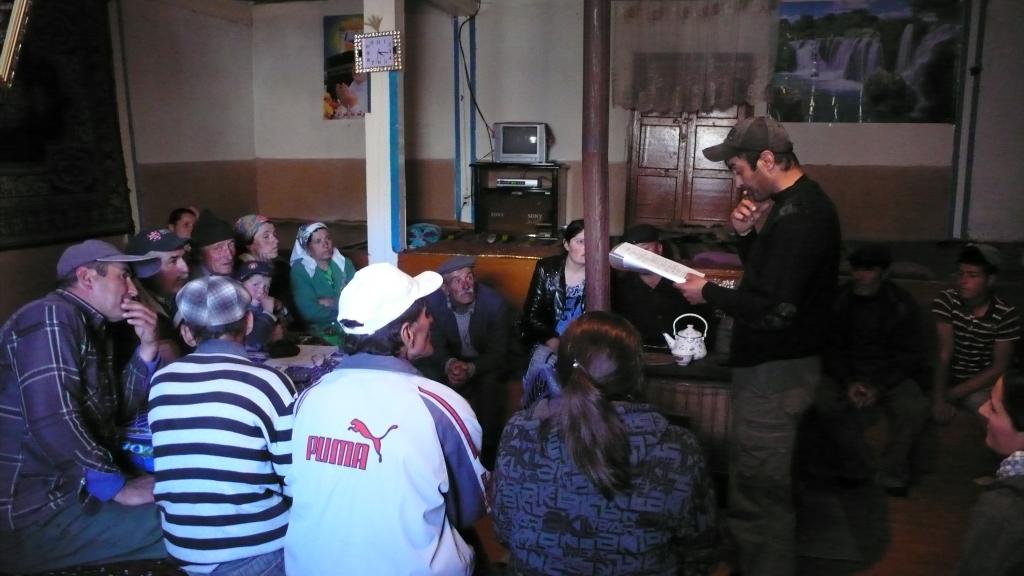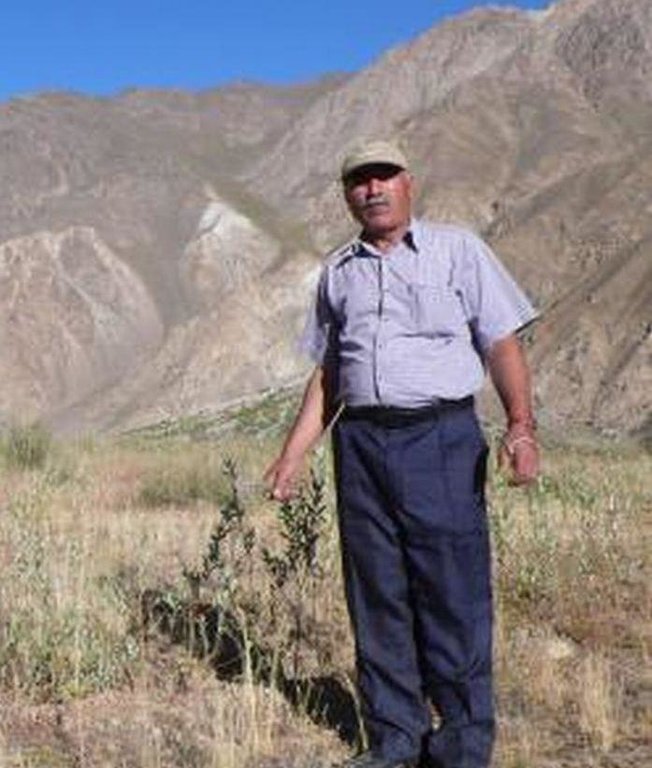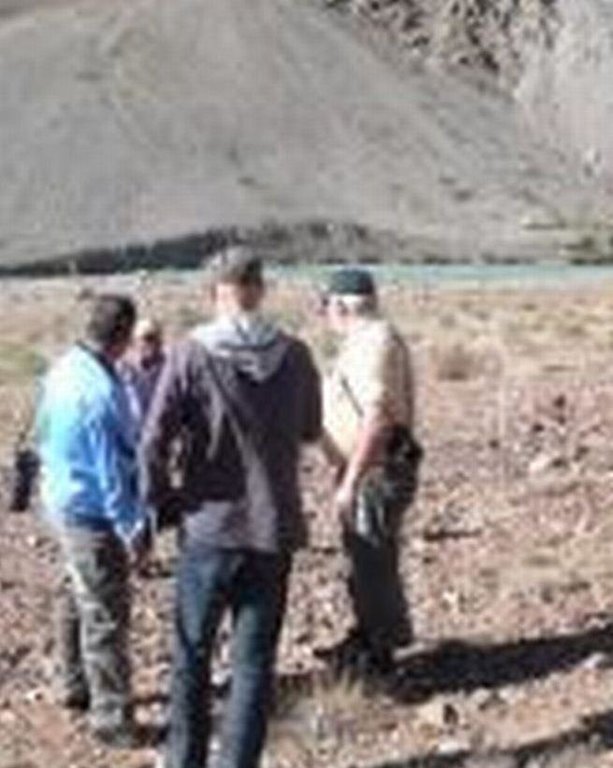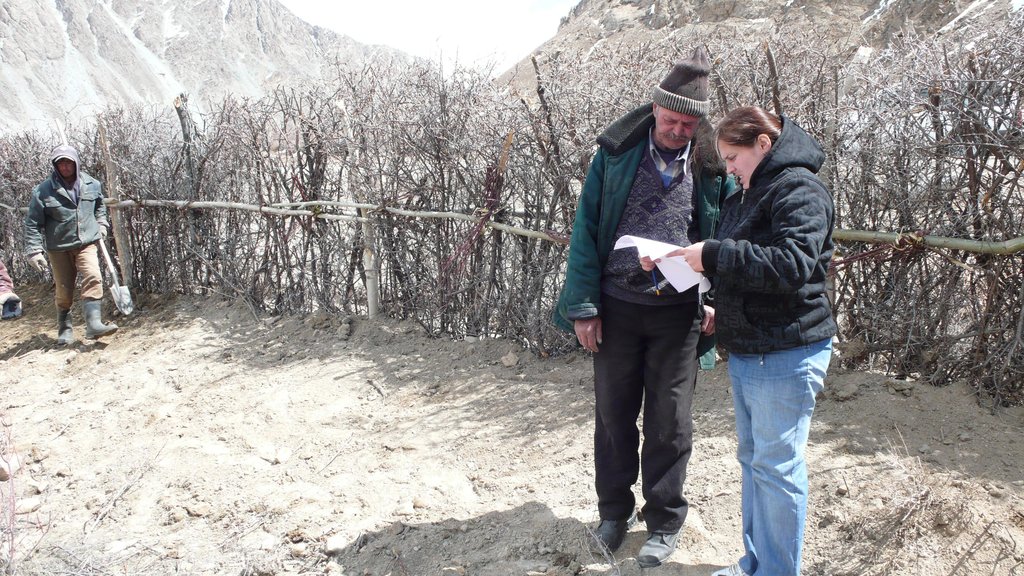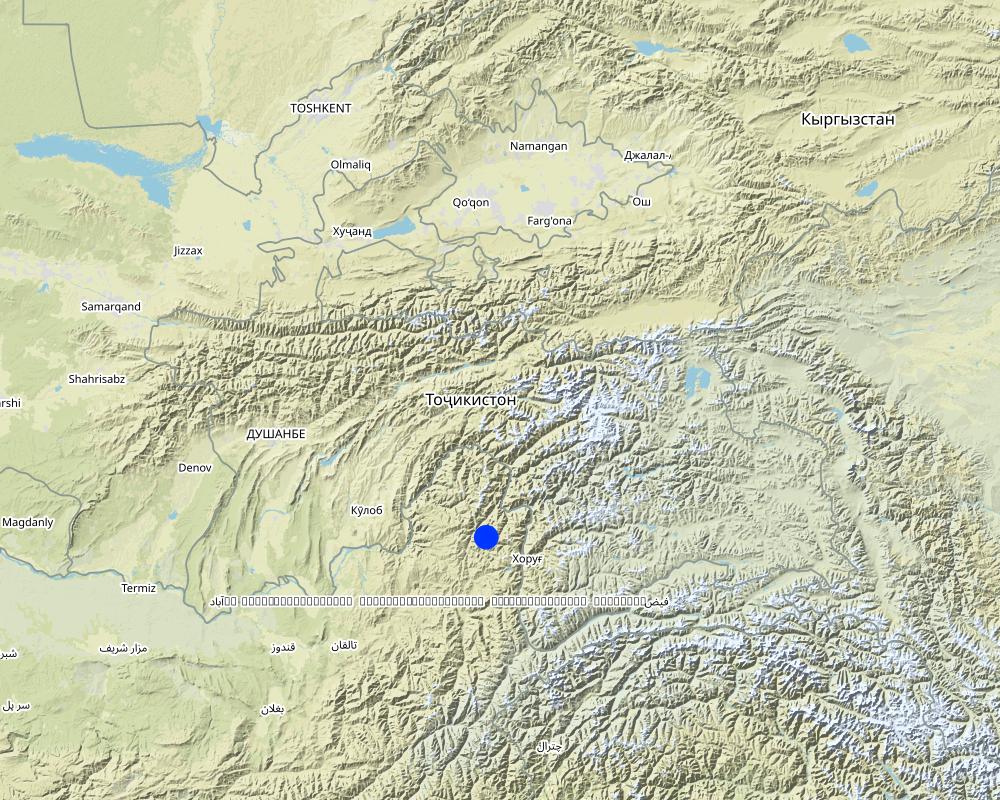Savings Book Approach [Tadjikistan]
- Création :
- Mise à jour :
- Compilateur : Roziya Kirgizbekova
- Rédacteur : –
- Examinateurs : David Streiff, Alexandra Gavilano, Joana Eichenberger
Sberegatelnaya knizhka (Russian)
approaches_2445 - Tadjikistan
Voir les sections
Développer tout Réduire tout1. Informations générales
1.2 Coordonnées des personnes-ressources et des institutions impliquées dans l'évaluation et la documentation de l'Approche
Spécialiste GDT:
Neusel Benjamin
benjamin.neusel@cimonline.de
GIZ
Sustainable Management of Natural Resources in Gorno-Badakhshan, Okhonjon Str. 58-1, 736000 Khorog
Allemagne
Spécialiste GDT:
Kirchhoff Joachim
+992 44 6006702
joachim.kirchhoff@giz.de
GIZ
Regional Program on Sustainable Use of Natural Resources in Central Asia, Ayni Str./Nazarshoev Str., 734026 Dushanbe
Allemagne
Nom du projet qui a facilité la documentation/ l'évaluation de l'Approche (si pertinent)
Pilot Program for Climate Resilience, Tajikistan (WB / PPCR)Nom du ou des institutions qui ont facilité la documentation/ l'évaluation de l'Approche (si pertinent)
Central Asian Countries Initiative for Sustainable Land Management - Multicountry Capacity Building (CACILM - MCB) - KirghizistanNom du ou des institutions qui ont facilité la documentation/ l'évaluation de l'Approche (si pertinent)
Deutsche Gesellschaft für Internationale Zusammenarbeit (GIZ) GmbH (GIZ) - Allemagne1.3 Conditions relatives à l'utilisation par WOCAT des données documentées
Quand les données ont-elles été compilées (sur le terrain)?
15/09/2010
Le compilateur et la(les) personne(s) ressource(s) acceptent les conditions relatives à l'utilisation par WOCAT des données documentées:
Oui
1.4 Références au(x) questionnaire(s) sur les Technologies de GDT
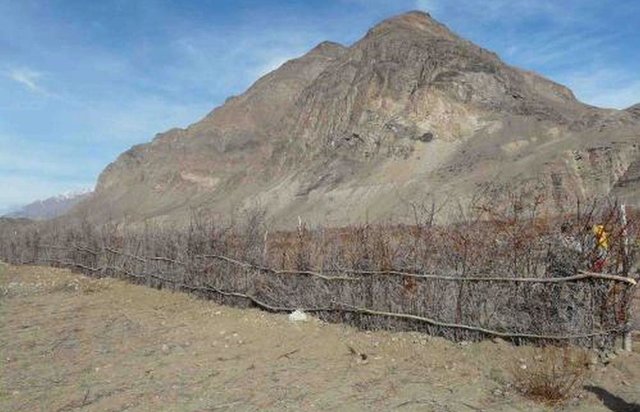
Establishment of living seabuckthorn fences for the protection … [Tadjikistan]
Protection of reforestation sites (willow, poplar and fruit trees) through living seabuckthorn perimeter fencing on Joint Forestry Management plots.
- Compilateur : Roziya Kirgizbekova
2. Description de l'Approche de GDT
2.1 Courte description de l'Approche
Reforestation of deserted state forest plots through a financial incentive system for the labour intensive first years of forest establishment, after which harvests of forest products from the plot provide income opportunities for the forest tenants and the State Forestry Agency (in the frame of CACILM).
2.2 Description détaillée de l'Approche
Description détaillée de l'Approche:
Aims / objectives: The main objective of the approach is the reforestation of a completely deserted former forest area in collaboration with the local population. However, as reforestation is highly labour intensive especially in the initial phases, this approach was developed as an incentive system to overcome this high-labour/low-income phase.
Methods: The underlying method is the implementation of Joint Forestry Management (JFM) on severely degraded forest plots (For JFM see approach TAJ015). In order to enable reforestation on such plots, an incentive system has been developed to bridge the gap when the initial workload is high, but no forest resources can yet be harvested. Therefore, selected forest tenants receive a savings book with a total amount of money to be obtained for forest rehabilitation work within the next six years. Every year clear planting and rehabilitation goals are formulated, which have to be completed by an agreed deadline. All tenants who completed their annual tasks will get access to a share of the total amount in the savings book. The annual shares gradually decreases over a period of six years, after which access to forest resources on the rehabilitated plot will be substantial enough to provide income opportunities and forest resources for their own consumption. According to the JFM contract, forest tenants hold a plot for a period of 20 years. This also applies for the savings book tenants, who act as regular JFM tenants after the subsidised reforestation period of six years is over.
Stages of implementation: The savings book approach is designed to cover a period of six years, and includes the following; (1) Before implementation; the willingness of the local population to participate needs to be assessed, the feasibility of reforestation, costs for irrigation, possibilities and the need for fencing and possible conflicts and challenges that might occur. (2) In the first year a living fence (seabuckthorn) has to be established, and the irrigation system has to be fully rehabilitated. (3) During the first three years of the approach implementation tenants will reforest one third of their plot each year (1-2 ha per household), introducing a rotation system that will be used for harvesting. (4) During years 4-6, mainly maintenance work will be conducted (pruning, fence and irrigation maintenance).
Role of stakeholders: The JFM rental contract is valid for 20 years and defines the rights and duties of the forest tenants and the State Forestry Agency. While the tenant is responsible for the agreed annual reforestation tasks, the Forestry Agency provides the required planting material, technical support and monitoring. The Micro Loan Organisation MADINA, facilitates the financial transactions required for the implementation and management of the savings books.
2.3 Photos de l'approche
2.5 Pays/ région/ lieux où l'Approche a été appliquée
Pays:
Tadjikistan
Région/ Etat/ Province:
Tajikistan, Gorno Badakhshan Autonomous Region
Autres spécifications du lieu :
Shugnan
Map
×2.6 Dates de début et de fin de l'Approche
Indiquez l'année de démarrage:
2010
Date (année) de fin de l'Approche (si l'Approche n'est plus appliquée):
2012
2.7 Type d'Approche
- fondé sur un projet/ programme
2.8 Principaux objectifs de l'Approche
The Approach focused mainly on SLM with other activities (Income generation, income diversification, reforestation of severely degraded forest areas, improved access to forest resources)
Reforestation and protection of severely degraded state forest plots in cooperation with the local forest users. At the same time, providing an incentive system for the initial reforestation phase, when a high workload is required but no forest products can be harvested. The main objective is therefore to combine forest rehabilitation with livelihood improvement (increased income generation and forest resource accessibility) and to directly involve the local population in the management and rehabilitation of the State forest resources close to their village. The approach will be implemented within the framework of Joint Forestry Management (see approach TAJ015).
The SLM Approach addressed the following problems: The forest area close to the village was completely destroyed during the civil war to meet urgent fuelwood needs. At the same time the State Forestry Agency does not have the necessary financial, management and control capacities to reforest degraded areas. Despite the presence of a forested area close to the village, local inhabitants do not have the labour force and the financial resources to rehabilitate the plot and the irrigation infrastructure on their own. These highly degraded or deserted forest plots aim to be re-established through the savings book approach, by combining long-term rental contracts for individual plots, financial incentives for the initial reforestation efforts, and user rights to the resources growing on the plot in future.
2.9 Conditions favorisant ou entravant la mise en œuvre de la(des) Technologie(s) appliquée(s) sous l'Approche
disponibilité/ accès aux ressources et services financiers
- entrave
On highly degraded plots the initial labour and financial input for reforestation is very high and cannot be met either by forest tenants nor by the State Forestry Agency.
Treatment through the SLM Approach: The plots are rented to local forest tenants, who receive a savings book with a certain amount of money for rehabilitation activities for six years. The work is strictly monitored and money can be accessed only if the annual tasks are completed.
cadre institutionnel
- entrave
The State Forestry Agency lacks the institutional capabilities to implement, manage and control reforestation and forest management activities.
Treatment through the SLM Approach: Income opportunities are handed over to local forest tenants. Forestry Agency staff are also trained in monitoring and sustainable management of the rented plots.
cadre juridique (régime foncier, droits d'utilisation des terres et de l'eau)
- entrave
Local inhabitants had no official user rights to the state forest plots close to their village and were using the plots illegally. Hence there is no real interest in rehabilitating the plots.
Treatment through the SLM Approach: The forest plots are rented and contracts, management and annual plans are established for each plot. Additionally, the major costs for reforestation are covered for the first few work intensive years.
The existing land ownership, land use rights / water rights moderately hindered the approach implementation Before the implementation of this approach the deserted forest area was governed by open access, although it formally belonged to the State Forestry Agency. Local villagers used it intensely as winter pastures. Therefore, not everybody was happy to restrict access to the area. However, it is clear to the local land users, that reforestation and irrigation rehabilitation will enable better access to forest products and fodder in the long run.
connaissances sur la GDT, accès aux supports techniques
- entrave
The State Forestry Agency lacks financial and technical resources to rehabilitate degraded forest areas and the respective irrigation infrastructure.
Treatment through the SLM Approach: Shortcomings in irrigation are analysed and improved at the beginning of rental agreements with local villagers. Technical and financial support from the project is provided where infrastructure needs much assistance.
charge de travail, disponibilité de la main-d'œuvre
- entrave
After the collapse of the Soviet Union, the State Forestry Agency had insufficient financial and human resources to manage the state forests.
Treatment through the SLM Approach: Through Joint Forestry Management and hence also through the savings book approach the workload in the forest (but also the incomes from forest products) is shared with local forest tenants.
3. Participation et rôles des parties prenantes impliquées dans l'Approche
3.1 Parties prenantes impliquées dans l'Approche et rôles
- exploitants locaux des terres / communautés locales
Forest plot tenants are the central implementing actors for reforestation
The approach is open to all economical categories within the village, regardless of age, status or ethnicity.
Several seminars on the design and implementation of the approach were held, whereas the whole community was invited, including men and women, young and old villagers
Although women and men were equally invited and encouraged to participate in the information seminars, most of the women felt that the work that would need to be done would need to be carried out by men.
As the work to be conducted was described as hard and strenuous, no women wanted to hold a forest plot under the savings book approach. However, women participated in discussions on the implementation of the approach and sometimes also took the place of men regarding decision making and implementation.
- Spécialistes de la GDT/ conseillers agricoles
Specialists from the project and the State Forestry Agency were the main actors for the design of the approach and its adaptation to local conditions
Initially developed in Vietnam, the approach was adapted and further developed by the GIZ project. During the design process, international as well as national specialists were involved, and inputs from local forest users were integrated as well.
- secteur privé
Micro-loan organisation MADINA
- gouvernement local
Governmental decision makers in the sphere of forestry and environmental management (State Forestry Agency of GBAO and Shugnan District)
- organisation internationale
Deutsche Geselschaft für Internationale Zusammenarbeit GmbH (GIZ)
3.2 Participation des exploitants locaux des terres/ communautés locales aux différentes phases de l'Approche
| Participation des exploitants locaux des terres/ communautés locales | Spécifiez qui était impliqué et décrivez les activités | |
|---|---|---|
| initiation/ motivation | interactive | Initial field visits, information seminars, discussions, involvement of the whole community. |
| planification | interactive | The technical planning of the approach was mainly conducted by forestry specialists, whereas the local villagers were consulted in an interactive way in order to adapt the approach to the specific conditions on site (e.g. solution of irrigation problem, planting techniques etc.). |
| mise en œuvre | soutien extérieur | After the initial reforestation phase the tenants will be involved in the participatory JFM system. |
| suivi/ évaluation | interactive | Progress and results are monitored in close cooperation between the State Forestry Agency, the plot tenants and project staff. Successes and challenges are documented and discussed, which if needed lead to an adaptation in the approach design. |
| Research | passive | Research is currently being conducted at a the local level, involving the local population as well as Forestry Agency staff for interviews and field visits. |
3.4 Prises de décision pour la sélection de la Technologie/ des Technologies
Indiquez qui a décidé de la sélection de la Technologie/ des Technologies à mettre en œuvre:
- principalement les spécialistes de la GDT, après consultation des exploitants des terres
Expliquez:
The savings book approach was initially developed and tested in Vietnam. The idea to implement such an approach in GBAO came from a GIZ project. Nevertheless, the local population was involved in several discussions about the adaptation of the approach to the local conditions.
Decisions on the method of implementing the SLM Technology were made by mainly by SLM specialists with consultation of land users
4. Soutien technique, renforcement des capacités et gestion des connaissances
4.1 Renforcement des capacités/ formation
Une formation a-t-elle été dispensée aux exploitants des terres/ autres parties prenantes?
Oui
Spécifiez qui a été formé:
- exploitants des terres
- personnels/ conseillers de terrain
Si pertinent, spécifiez le genre, l'âge, le statut, l'ethnie, etc.
As for JFM (see approach TAJ015), in the first step 'mobilisers' and Forestry Agency staff were trained as field staff. In the second step, they provided training, information and advice for the forest tenants.
Formats de la formation:
- sur le tas
- zones de démonstration
- réunions publiques
- cours
Thèmes abordés:
Sustainable natural resource management, technical forest management (cutting and planting of trees, maintenance of a forest area, building of living seabuckthorn fences), elaboration of management plans and annual plans for a sustainable and joint management of the forest plot between forest tenants and the State Forestry Agency.
4.2 Service de conseils
Les exploitants des terres ont-ils accès à un service de conseils?
Oui
Spécifiez si le service de conseils est fourni:
- dans les champs des exploitants?
Décrivez/ commentez:
Name of method used for advisory service: Forestry training for tenants; Key elements: Sustainable natural resource management and use, Technical training in forestry management (planting and harvesting, fencing etc.)
Advisory service is quite adequate to ensure the continuation of land conservation activities; Strong interest from tenants as well as State Forestry Agency to continue with this approach. However, due to the short time the approach is being implemented, still more training and practice will be needed to ensure an experienced, effective and reliable advisory service by Forestry Agency staff.
4.3 Renforcement des institutions (développement organisationnel)
Des institutions ont elles été mises en place ou renforcées par le biais de l'Approche?
- oui, modérément
Spécifiez à quel(s) niveau(x), ces institutions ont été renforcées ou mises en place:
- local
Précisez le type de soutien:
- financier
- renforcement des capacités/ formation
Donnez plus de détails:
The State Forestry Agency is being trained and supported to implement and monitor the approach on their own, and to offer advisory services. Additionally the forest tenants are encouraged and supported to act as a group and to advocate their needs and problems as a local civil society organisation
4.4 Suivi et évaluation
Le suivi et l'évaluation font ils partie de l'Approche? :
Oui
Commentaires:
technical aspects were ad hoc monitored by project staff, government through observations; indicators: condition of the irrigation and fencing infrastructure
socio-cultural aspects were ad hoc monitored by project staff, land users through observations; indicators: discussion of problems and challenges
economic / production aspects were regular monitored by project staff, government through observations; indicators: control of planting process, technical advice
economic / production aspects were regular monitored by project staff, government through measurements; indicators: control of seedlings planted (first 4 years), amount of harvested forest products (from 5th year on)
area treated aspects were regular monitored by project staff, government through measurements; indicators: monitoring of area planted at the end of planting period, enable withdrawal of money if satisfactory
management of Approach aspects were ad hoc monitored by project staff through observations; indicators: monitoring of successes and challenges, adaptation of approach if needed
management of Approach aspects were regular monitored by project staff through measurements; indicators: allocated funds to forest tenants, overall performance of approach: reforestation achieved
There were several changes in the Approach as a result of monitoring and evaluation: As the Saving Book Approach is implemented as a pilot project, results from monitoring and evaluation were mainly collected as lessons learnt, which will be highly helpful to adapt and perfectionnate the approach for further implementation sites.
There were no changes in the Technology as a result of monitoring and evaluation: None
4.5 Recherche
La recherche a-t-elle fait partie intégrante de l’Approche?
Oui
- socio-economic, on-site situation analysis
Donnez plus de détails et indiquez qui a mené ces recherches:
A Tajik Masters student enrolled at the university of Bayreuth is currently conducting transdisciplinary field research on the perception, willingness to participate and opportunities for further distribution of the approach in GBAO. The results will help to develop a model for further evaluation of potential sites for the approach and to identify areas of difficulty.
Research was carried out both on station and on-farm
5. Financement et soutien matériel externe
5.1 Budget annuel de la composante GDT de l'Approche
Si le budget annuel précis n'est pas connu, indiquez une fourchette:
- 10 000-100 000
Commentez (par ex. principales sources de financement/ principaux bailleurs de fonds):
Approach costs were met by the following donors: local community / land user(s) (Local forest plot tenants): 10.0%; international (Deutsche Geselschaft für Internationale Zusammenarbeit GmbH (GIZ)): 80.0%; private sector (Micro-loan organisation MADINA): 5.0%; local government (district, county, municipality, village etc) (State Forestry Agency of GBAO and Shugnan District): 5.0%
5.2 Soutiens financiers/ matériels fournis aux exploitants des terres
Les exploitants des terres ont-ils reçu un soutien financier/ matériel pour la mise en œuvre de la Technologie/ des Technologies?
Oui
Si oui, spécifiez le(s) type(s) de soutien, les conditions et les fournisseurs:
As the approach aims to reforest strongly degraded forest areas, the forest tenants are rewarded with financial compensation for the initial years without direct income opportunities from the plot.
5.3 Subventions pour des intrants spécifiques (incluant la main d'œuvre)
- équipement
| Spécifiez les intrants subventionnés | Dans quelle mesure | Spécifiez les subventions |
|---|---|---|
| machines | en partie financé | partly excavator work |
| outils | en partie financé | hand tools |
- intrants agricoles
| Spécifiez les intrants subventionnés | Dans quelle mesure | Spécifiez les subventions |
|---|---|---|
| seedlings | en partie financé | |
- infrastructures
| Spécifiez les intrants subventionnés | Dans quelle mesure | Spécifiez les subventions |
|---|---|---|
| Irrigation infrastructure | entièrement financé | rehabilitation of irrigation channel and fence |
- autre
| Autre (spécifiez) | Dans quelle mesure | Spécifiez les subventions |
|---|---|---|
| Transport costs (planting and fencing material) | entièrement financé | Fuel and rent of lorry |
Si la main d'œuvre fournie par les exploitants des terres était un intrant substantiel, elle était:
- payée en espèces
Commentaires:
Labour was carried out voluntarily as well
5.4 Crédits
Des crédits ont-ils été alloués à travers l'Approche pour les activités de GDT?
Non
5.5 Autres incitations ou instruments
D'autres incitations ou instruments ont-ils été utilisés pour promouvoir la mise en œuvre des Technologies de GDT?
Oui
Si oui, spécifiez:
The State Forestry Agency is being trained and supported to implement and monitor the approach on their own, and to offer advisory services. Additionally the forest tenants are encouraged and supported to act as a group and to advocate their needs and problems as a local civil society organisation
6. Analyses d'impact et conclusions
6.1 Impacts de l'Approche
Est-ce que l'Approche a aidé les exploitants des terres à mettre en œuvre et entretenir les Technologies de GDT?
- Non
- Oui, un peu
- Oui, modérément
- Oui, beaucoup
The deserted forest area is being reforested for the benefit of the villagers and the State Forestry Agency. Due to the establishment of contracts with the local population they acquire ownership and responsibility for the forest areas close to their village.
Est-ce que l'Approche a autonomisé les groupes socialement et économiquement défavorisés?
- Non
- Oui, un peu
- Oui, modérément
- Oui, beaucoup
As disadvantaged groups are more dependent on the diversification of income sources, the most susceptible households could benefit from generated income through reforestation work.
Est-ce que l'Approche a amélioré les questions foncières et des droits d'utilisation qui entravent la mise en œuvre des Technologies?
- Non
- Oui, un peu
- Oui, modérément
- Oui, beaucoup
Via the approach clear property and user rights have been established. Of course conflicts have so far appeared during the whole implementation process, which are being discussed whenever they occur. However, clear user rights have stopped the open access scenario and provide incentives for labour investments in conservation and reforestation activities.
Did other land users / projects adopt the Approach?
- Non
- Oui, un peu
- Oui, modérément
- Oui, beaucoup
As the pilot project is still running no other sites have been started yet. However, there is strong interest from the forest tenants as well as the State Forestry Agency to further disseminate the approach.
Did the Approach lead to improved livelihoods / human well-being?
- Non
- Oui, un peu
- Oui, modérément
- Oui, beaucoup
So far no increase of income or own consumption of forest products from the plot has been reached. But forest tenants get income from their savings book according to the amount of work they have done
Did the Approach help to alleviate poverty?
- Non
- Oui, un peu
- Oui, modérément
- Oui, beaucoup
Income from the savings book reduces economic vulnerability during hard times.
6.2 Principale motivation des exploitants des terres pour mettre en œuvre la GDT
- augmenter la production
Increased wood production for own consumption and market
- paiements/ subventions
Payments of incentives for initial reforestation contribute to livelihood
- règles et règlements (amendes)/ application
Contract based legal access to forest resources
- améliorer l'esthétique
A green forest area improves attractiveness of the village surroundings
- well-being and livelihoods improvement
Income for reforestation and access to fresh resources improve local livelihoods
6.3 Durabilité des activités de l'Approche
Les exploitants des terres peuvent-ils poursuivre ce qui a été mis en œuvre par le biais de l'Approche (sans soutien extérieur)?
- incertain
Si non ou incertain, spécifiez et commentez:
Currently the approach is still in its testing phase. However, the savings book approach has been designed in a way to ensure sustainability, as after the work-intensive initial phase, the forest tenants will be able to generate income from the forest resources.
6.4 Points forts/ avantages de l'Approche
| Points forts/ avantages/ possibilités du point de vue de l'exploitant des terres |
|---|
| A financial incentive system bridges the period where a lot of work input is required, but the plot still doesn't provide any benefit. (How to sustain/ enhance this strength: Provide advisory and regular monitoring in order to allow the tenants to achieve the fixed annual goals and get access to their annual share of money.) |
| In the long run, forest tenants have a benefit from the reforested plot in the form of legal access to forest products (firewood, timber, hay, fruits and berries etc.). (How to sustain/ enhance this strength: Support the creation of marketing opportunities for forest products.) |
| Points forts/ avantages/ possibilités du point de vue du compilateur ou d'une autre personne ressource clé |
|---|
| Completely deforested former forest plots can be reforested and livelihoods sustained at the same time. (How to sustain/ enhance this strength: Foster trust between the State Forestry Agency and the local forest tenants.) |
| Sustainable management of the plot in future is enabled through JFM. (How to sustain/ enhance this strength: Support ownership creation for the reforested area among tenants and the Forestry Agency.) |
6.5 Faiblesses/ inconvénients de l'Approche et moyens de les surmonter
| Faiblesses/ inconvénients/ risques du point de vue de l’exploitant des terres | Comment peuvent-ils être surmontés? |
|---|---|
| Benefits from the forest plot will be possible only after 5 to 6 years. | Bridge the initial phase with income from the savings book, build up marketing opportunities for the forest products to be harvested in future. |
| The plot will no longer be freely accessible for other land use types such as grazing of livestock. | Provide platforms to discuss arising conflicts, show and support opportunities for winter fodder production on the forest plot. |
| Faiblesses/ inconvénients/ risques du point de vue du compilateur ou d'une autre personne ressource clé | Comment peuvent-ils être surmontés? |
|---|---|
| Through the high initial labour input the costs for the implementation of this approach are rather high. | Document and promote experiences of the pilot project, enable dissemination, as the establishment of larger areas reduce the costs per ha. |
| The approach is designed for a time period of a minimum of six years, at the end of which there might be less external technical support. | Continue and improve training of Forestry Agency staff to enable a sustainable continuation. |
7. Références et liens
7.1 Méthodes/ sources d'information
- visites de terrain, enquêtes sur le terrain
- interviews/entretiens avec les exploitants des terres
Liens et modules
Développer tout Réduire toutLiens

Establishment of living seabuckthorn fences for the protection … [Tadjikistan]
Protection of reforestation sites (willow, poplar and fruit trees) through living seabuckthorn perimeter fencing on Joint Forestry Management plots.
- Compilateur : Roziya Kirgizbekova
Modules
Aucun module trouvé


